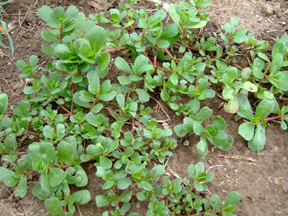
During my Thursday garden demos in Lehman’s retail store in Kidron, Ohio, I stock my table display with conversation starters and educational tools from our farm. Churning butter prompts stories from folks who churned many a batch in their youth. On the plate of freshly harvested veggies, people often inquire about the bright yellow pattypan squash or the unique Mexican Sour Gherkins and in the bouquet of flowers, Bells of Ireland are the main attraction.
Even with all these fun things, the most popular display is likely my humble plate of edible weeds. Unless you have a perfectly landscaped and chemical-sprayed yard, everyone grows weeds and is curious to learn which ones they can safely put on the supper table.
Lately, the weed that has garnered the most attention on my display plate is purslane. This is the red stemmed, teardrop leafed, ground hugging, hard to kill pesky weed that everybody has growing in their flowerbed, driveway or garden. Since this weed has succulent qualities, it also thrives well during drought conditions that we are experiencing right now in northeast Ohio. The redeeming quality of this weed is that you can eat it. The succulent leaves taste somewhat like lettuce with a hint of lemon and mix well in a salad. I added them to coleslaw the other night and the Simply in Season cookbook (available in the retail store) even contains a recipe for purslane salad on page101.

My Mexican aunt gathered purslane one summer when she was visiting and sauted it with onions and herbs for a tasty side dish. An Amish friend shared that she chops it up fine to serve with eggs for breakfast. So it is quite versatile in ways to prepare it.
Not only is this weed a tasty addition to your meals, it also packs a nutritional punch. Purslane contains the highest amount of omega 3 fatty acids for a vegetable plus a good dose of vitamins A and C along with several minerals. It is perhaps the most nutritious thing many of us are growing.
I am confident that a few Lehman’s shoppers are trying purslane on their supper plates after learning about it on my demo table and at least one lady decided that she could now consider herself a gardener since she grows edible weeds in her yard. One family was even disappointed that they had just sprayed weed killer on a lovely bed of purslane the day before. From our abundance, I added bags of purslane to my veggie customer baskets with instructions on how to use it If you look carefully you might discover some at the local farmers’ market.
Before you start gathering weeds for your table, be sure of proper identification (see photo above or ask a seasoned gardener) and you want to be careful to gather from areas not sprayed with chemicals or frequented by pets. Then you are free to gather, wash and prepare a healthy supper foraged right from your yard.





























Eat your lamb’s quarter, too!
I just learned about pigweed this year, it is so good and I keep finding it everywhere!
I have a great recipe for purslane , parsley and tomato salad — all growing in my garden right now
I have been pulling up this stuff for years, now I can’t find any around the yard. I will have to be more judicious when pulling up the early spring weeds.
I have some of this growing at the edge of my driveway and couldn’t remember what it was called.
I have a bumper crop of it this year and we’ve been eating it almost every day in some form or another.
This stuff is spreading EVERYWHERE in my garden, yard–everything! I *have* to pull it, as it crowds out the stuff I’m trying to grow on purpose :)
It is acting as a good mulch growing under my watermelon and cucumber vines.
Are you kidding me? I think I’ve been pulling this out of my garden by the bagful and tossing it out. Ugh! Reset mindset….